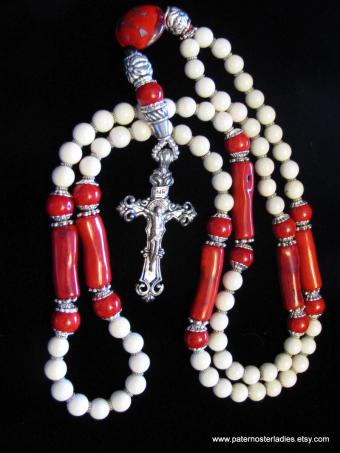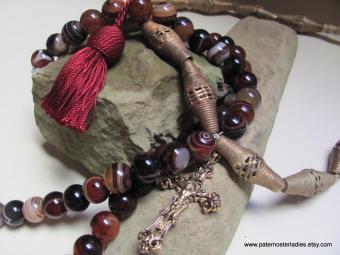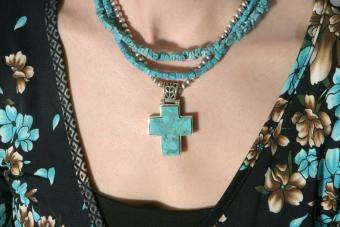
Grace Martin's love of medieval history and art led her to join a medieval living history group. Her experiences reenacting history inspired her to create a collection of medieval style religious jewelry. Her jewelry business, Paternoster Ladies, now includes four jewelry artists who bring their expertise in medieval history and religion to create heirloom quality replicas of medieval paternosters and rosaries.
Introducing the Paternoster Ladies
Based in Brighton, Michigan, Paternoster Ladies is an online jewelry business run by a group of women with expertise and experience in medieval history, religion and jewelry design. Each woman lends her personal experiences and expertise to the jewelry. Grace Martin, a graduate of Duke University, is the business owner and principal jewelry designer and also a stay-at-home mom. Laura Messer is a nursing student and seamstress. Connie Harriff works in a church. Former art gallery employee Leslie Wilbanks has a Master's degree in art.
Grace Martin of Paternoster Ladies
Grace Martin enjoyed medieval history reenactment, which led to much research into details of early jewelry and clothing. When she discovered that it was difficult to locate a historically accurate paternoster or early rosary, she started making paternosters based on her research. Soon afterwards, Paternoster Ladies was born.
Living History in Jewelry
LoveToKnow (LTK): What is the founding story of the Paternoster Ladies shop?
Grace Martin (Martin): I have always been an avid collector of vintage and antique jewelry, and the idea to actually design something so meaningful both then and now in a historically accurate way challenged me.
Until Paternoster Ladies, few designers focused on the historical accuracy of rosaries and medieval prayer beads. I feel that the ancient designs have a simplicity and rich beauty that attracts collectors of all types.
For me, creating a paternoster is about infusing each piece with "heirloom character." I believe in investing time and effort into creating a piece that is not only beautiful to the eye but also to the touch. Historically, paternosters were handled much more than any piece of jewelry that we wear or use today, and I believe that the feel of a piece matters just as much as the look.
LTK: What led to your interest in designing handmade paternosters?
Martin: My interest in medieval rosaries was sparked while doing research into 12th, 13th and 14th century women's clothing in Europe.
I belong to a medieval living history group, and we spend a great deal of time researching historical documents, museum artifacts and paintings in order to create historically accurate medieval clothing.
Accessories are very important to complete the look, and the ladies in our group chose to make paternosters to add authenticity to our garments. I found the subject fascinating and spent several years researching the subject.
But the idea for going into business didn't occur until two years ago. As part of a project for our group, we were challenged to create 50 medieval items, and of course I chose to make paternosters. I was surprised and delighted by the interest others expressed when they viewed my work and began taking select custom orders. Paternoster Ladies was born!
Medieval Style Religious Jewelry Is Unique
LTK: How does medieval style religious jewelry differ from modern versions?
Martin: Medieval paternosters served many purposes and were very common during the medieval era. Most people are familiar with the current day rosary but may not have realized that it did not assume its familiar standardized form until the late 16th century. While used to keep count of prayers, they served in many other vital ways to the medieval man or woman.
Demonstrations of piety served an important part of medieval life, and paternosters varied greatly depending on the religious order or sets of prayers for which they were being used. Paternosters also varied in the number of beads, the materials used, and the way in which they were worn.
Paternosters also served as an open display of piety and wealth. Expensive materials were used to demonstrated high social stature and influence. Even as Medieval sumptuary laws (laws that regulated and reinforced social hierarchies and morals through restrictions on clothing, food and luxury expenditures) were enacted in the mid-1300s, no limitations were placed on the materials used in paternosters, since they honored God. Thus, these beads became an important way for merchants and businessmen to openly display their wealth and social stature.

Despite their obvious purpose in Christian worship, medieval paternosters were often made from materials that were believed to hold talismanic powers, such as the ability of amethyst to clear a man's head from wine or coral's ability to cleanse and protect. Obviously, these meanings stemmed from an earlier time, and these different materials meant something, much like our birthstones or Victorian-era flower language.
Merchants used them as a counting tool, much like an abacus on a string. Anything that needed counting could be tabulated using these beads. They were also one of the only items of value that could be owned by a woman, and passed down to her heirs. Paternosters were even used to keep time. Many medieval recipes of the day measured cooking times by a certain number of prayers (boil for 14 Aves).
Finally, paternosters were also used as a sort of medieval "charm bracelet." Reliquaries, charms and pilgrim badges and tokens were often hung from a person's rosary, along with personal charms that identified heraldry and household badges. They were an important and necessary part of medieval life, much like today's cell phone.
Materials and Design Techniques
LTK: What types of materials do you use in your jewelry design?
Martin: My materials range from bone, horn and wood, to agate, chalcedony, Venetian glass and lapis lazuli. I am currently designing a solid amber piece and look forward to working with ruby and emerald in the future. I enjoy working with red coral and pearls and jet. For metals, I use brass, pewter and sterling and have occasionally used vermeil.
In order to keep my paternosters accessible, I most often choose to use pre-made tassels; however, handmade silk tassels are available on my custom work by request.

LTK: Please describe your jewelry design techniques.
Martin: I find inspiration for my pieces primarily from medieval art. Once I choose the combinations of color and materials, I often let them percolate in my mind before beginning on the piece.
Making Historically Accurate Jewelry
LTK: You make historical jewelry. What type of research do you do before designing a piece?
Martin: When designing a piece, I reference my past collected research, first by period, then by region. I have gathered a tremendous amount of knowledge that I use to determine materials (and their availability by region) and constantly seek to add to my reference library.
I make sure that the materials were available and the types of glass beads were accurate. I find that the charm of uneven, handmade or hand cut gemstones, and glass are more appealing to me than today's laser-cut perfection. When the exact materials are unavailable or impractical to use, I choose the next best alternative, trying to maintain the spirit of the piece.
Of course we make pieces too, that are "historically-inspired." But the main thrust of our business is that we can provide the knowledge to make something beyond pretty - we make heirlooms and history come to life.

LTK: How difficult is it to make jewelry historically accurate?
Martin: The hardest part is the struggle regarding the stringing material. Paternosters of the day were often strung loosely and slid up and down as prayers were counted. This creates friction which frays the cord, causing breakage. Many paternosters recorded from the medieval era are missing a bead here and there, as if they were lost when the item "blew out" and then was restrung.
While wire was used to string some rare and expensive paternosters, most often the middle class paternosters were strung from silk. Rare examples exist of paternosters strung on their original material. Museums often discarded original examples when the beads were restrung. There is much debate as to how the stringing material was woven to provide the strongest cord. While I do still string with silk, I have come to rely on modern materials to offer extra support.
Discover Paternoster Ladies Jewelry
To learn more about Paternoster Ladies or purchase jewelry, please visit their Facebook page and blog. The shop also takes custom orders.
LoveToKnow thanks Grace Martin for the interview and the introduction to her inspirational art jewelry.







